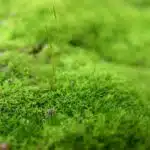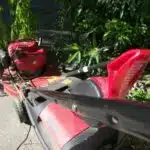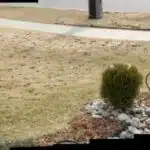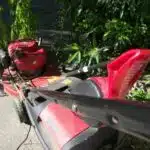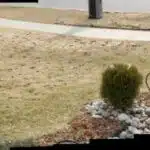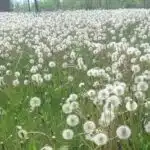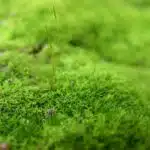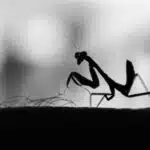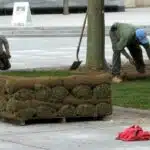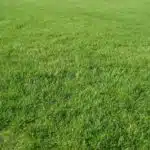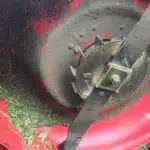Mushrooms are a common sight in many yards, especially during the wet season. While some may find them charming and a sign of healthy soil, others may view them as an eyesore and a potential hazard to their pets and children. While there are various commercial products available to eradicate mushrooms, they often contain harmful chemicals that can harm the environment and even grass itself. In this article, we will explore natural methods that can help you get rid of mushrooms in your yard without causing any harm to the ecosystem.
As a horticulture expert, it is essential to understand that mushrooms play a vital role in breaking down organic matter and adding nutrients to the soil. However, excessive mushroom growth can indicate an imbalance in your lawn’s ecosystem. It could be due to over-watering or poor drainage, which creates the ideal environment for mushroom growth. By taking necessary steps to address these underlying issues, you can naturally reduce the number of mushrooms in your yard without harming other beneficial organisms such as earthworms or microbes. In this article, we will provide tips on how to identify different types of mushrooms and natural methods to prevent them from growing back in your yard.
Understanding The Role Of Mushrooms In Your Yard
When it comes to having mushrooms in your yard, it’s important to understand their role in the ecosystem. Mushrooms are a type of fungus that grows by feeding on decaying organic matter, such as dead leaves or fallen trees. Their main function is to break down these materials and release nutrients back into the soil, which benefits other plants in the area.
Mushroom cultivation has been around for thousands of years, and there are many different types of mushrooms that can be grown for food or medicinal purposes. In fact, there are countless mushroom recipes out there that are both delicious and nutritious! However, when it comes to wild mushrooms growing in your yard, it’s important to exercise caution since not all varieties are safe for consumption.
Identifying different types of mushrooms can be challenging since they come in all shapes, sizes and colors. Some common types that you may come across include button mushrooms, shiitake mushrooms and portobello mushrooms. It’s important to note that while some wild mushrooms are edible and delicious, others can be poisonous or even deadly. Therefore, before attempting to consume any wild mushroom growing in your yard or elsewhere, it’s crucial to properly identify it first.
Identifying Different Types Of Mushrooms
Understanding the role of mushrooms in your yard is essential before you begin to identify different types of mushrooms. These fungal organisms play a crucial part in breaking down organic matter and recycling nutrients back into the soil. Without mushrooms, the soil would become compacted, and plant life would struggle to thrive. However, excessive mushroom growth can be unsightly and potentially hazardous.
Identifying common mushrooms is an important step in managing their growth in your yard. Some species are harmless and even edible but others are poisonous and should never be consumed. Common varieties found in yards include puffballs, shiitakes, and portobellos. It’s important to note that identifying mushrooms can be challenging for beginners, as some species look similar to one another.
Understanding poisonous varieties is also crucial when it comes to managing mushrooms in your yard. Some species contain toxins that can cause severe illness or even death if ingested. Symptoms of poisoning can include nausea, vomiting, abdominal pain, hallucinations, seizures, or coma. If you suspect poisoning from mushroom consumption, seek medical attention immediately.
Excessive mushroom growth can indicate underlying issues with soil health or drainage problems. In the next section, we’ll explore symptoms of excessive mushroom growth and how to naturally get rid of them without harming your lawn or garden.
Symptoms Of Excessive Mushroom Growth
Excessive mushroom growth is a common problem often found in residential gardens and yards. Large amounts of mushrooms can indicate an imbalance of nutrients in the soil, or an excess of moisture. Unnatural colorations, such as yellow, purple or blue, are also an indicator that something is off balance in the environment. In order to naturally get rid of mushrooms, it is important to identify the underlying cause and take the necessary steps to restore the balance of the environment.
Large Amounts Of Mushrooms
Mushrooms are a common sight in gardens and lawns, but their excessive growth can indicate an underlying issue with fungal ecology. Large amounts of mushrooms in your yard can indicate that there is decaying organic matter beneath the soil’s surface, such as buried wood or dead roots. This type of environment provides an ideal breeding ground for fungi to thrive, causing toadstool toxicity that can be harmful to pets and children.
To naturally get rid of mushrooms in your yard, it is important to address the root cause of the excessive fungal growth. Start by removing any sources of organic matter that may be contributing to the problem, such as fallen leaves, twigs or dead plant material. Additionally, ensure that your lawn is getting enough sunlight and air circulation by pruning overhanging trees and shrubs.
Another way to control mushroom growth is by improving soil drainage. Mushrooms thrive in damp environments, so make sure your lawn has proper drainage systems installed or consider aerating the soil to improve water penetration. Lastly, avoid using chemical fungicides as they can harm beneficial microorganisms in the soil and are not effective at controlling large amounts of mushrooms.
In conclusion, addressing the underlying cause of excessive mushroom growth is essential for naturally getting rid of them in your yard. By incorporating healthy gardening practices such as removing organic matter and improving soil drainage, you can create a healthier environment for your lawn while reducing the risk of toxic exposure from these fungi.
Unnatural Colorations
As a horticulture expert, it is important to identify the symptoms of excessive mushroom growth in your yard. While the presence of mushrooms can be a common sight in gardens and lawns, unnatural colorations on their caps can indicate toxic exposure. Exploring mushroom toxicity is crucial for your safety and that of your pets and children.
Mushrooms are cultivated using different techniques that affect their texture, flavor, and color. However, when growing unnaturally in your yard, they pose a risk of poisoning due to the accumulation of heavy metals or pesticides. Unnatural colorations such as blue or green on mushroom caps can be an indication of contaminated soil. It is essential to ensure that any sources of contamination are removed from your yard to prevent further exposure.
If you notice unnatural colorations on mushrooms growing in your yard, it is vital to take immediate action by removing them carefully and safely disposing of them. Avoiding chemical fungicides is advisable as they can harm beneficial microorganisms in the soil. Instead, opt for natural methods such as improving soil drainage and removing organic matter to discourage excessive mushroom growth. By taking these measures, you can create a safe environment for your family while reducing the risk of toxic exposure from mushrooms.
Assessing Your Lawn’s Ecosystem
Ah, the great outdoors! Nothing beats the sensation of feeling the sun on your skin and taking in the fresh air. Unless, of course, you’re surrounded by pesky mushrooms infesting your yard. Fear not! Before we get to the nitty-gritty of addressing over-watering and poor drainage, let’s assess your lawn’s ecosystem.
The importance of biodiversity cannot be overstated when it comes to maintaining a healthy lawn. Just like how our bodies need a diverse range of nutrients to thrive, so too does your grass require a variety of microorganisms and insects to remain healthy. In fact, having a thriving insect population is crucial for optimal lawn health as they help aerate soil and break down organic matter.
Speaking of organic matter, composting benefits are aplenty. Not only does compost provide valuable nutrients for your lawn without harmful chemicals often found in fertilizers, but it also helps suppress fungal diseases that can lead to mushroom growth. Creating a DIY compost bin is an easy and cost-effective way to start benefiting from this natural process – all you need is some patience and dedication!
Now that we’ve established the role of insects in lawn health and composting benefits, let’s move onto addressing over-watering and poor drainage. It’s crucial to identify any areas where water may be pooling or not draining correctly as this can create an environment conducive to mushroom growth. Stay tuned for our next section on how to properly address these issues without compromising your lawn’s overall health!
Addressing Over-Watering And Poor Drainage
Understanding the ecosystem of your lawn is crucial in addressing the issue of mushrooms. Another factor that affects mushroom growth is soil pH. Mushrooms thrive in acidic soil, so if your lawn’s pH level is below 6.0, it may encourage their growth. Therefore, it is essential to test your soil’s pH level and adjust it accordingly.
Improving soil structure can also help prevent mushroom growth. A dense and compacted soil can retain water, leading to poor drainage and excess moisture – perfect conditions for mushrooms to grow. Consider aerating your lawn regularly to improve soil structure, which will allow air and water to penetrate better into the ground.
Incorporating organic matter into your lawn can also help promote a healthy environment for grass while deterring mushrooms from growing. Using natural fertilizers such as compost or aged manure can provide nutrients that grass needs while improving soil structure and promoting beneficial microorganisms in the soil. By creating a healthier environment for your lawn, you are reducing the likelihood of mushroom growth as well as promoting overall lawn health.
To further enhance this process, we will discuss how using natural fertilizers can benefit your yard in the next section without relying on synthetic chemicals that are harmful to both humans and the environment.
Using Natural Fertilizers To Promote Lawn Health
Creating a healthy lawn is the key to eliminating mushrooms naturally. One way to achieve this is by using natural fertilizers that promote the health of your lawn. Composting benefits not only your garden but also your lawn. Incorporating compost into your soil can improve soil fertility and structure, reducing the need for pesticides and other chemical treatments.
Soil amendments such as bone meal, rock phosphate, and kelp meal can also naturally enhance the health of your lawn. These amendments provide essential nutrients to your soil, which in turn promotes root development and overall plant health. By utilizing these natural fertilizers, you are providing a sustainable solution to preventing future mushroom growth.
It’s important to note that maintaining proper soil pH levels is also crucial to promoting a healthy lawn. Soil testing kits can be purchased at most garden centers or through online retailers. Understanding your soil’s pH level can help determine what type of natural fertilizer will work best for your lawn. In the next section, we will discuss how aerating your lawn can further enhance its health and prevent future mushroom growth.
Aerating Your Lawn
Aerating your lawn can improve its overall health and appearance while also helping to get rid of mushrooms. Aerating involves perforating the soil with small holes, allowing air, water, and nutrients to penetrate the grass roots more effectively. This process helps to break up compacted soil, reducing thatch buildup, and promotes better root growth.
One of the most significant benefits of aerating is improved water absorption. When soil becomes compacted, water runs off instead of being absorbed into the ground. By aerating your lawn, you create channels in the soil that allow for better water absorption and less runoff. Additionally, aerating helps to reduce soil compaction by loosening the topsoil layers.
To successfully aerate your lawn, you need specific tools made for this purpose. The two most popular types of equipment used for aeration are spike aerators and plug aerators. Spike aerators use spikes or tines to punch holes into the ground without removing any soil. Plug aerators remove small plugs of soil from the ground as they perforate it. Both types have their advantages and disadvantages depending on the specific needs of your lawn.
Removing excess organic matter is another important step in getting rid of mushrooms in your yard. By thoroughly removing any debris or dead plant matter from your lawn before and after aeration, you can help prevent fungal growth in areas where excess moisture accumulates. With proper aeration techniques and consistent maintenance practices such as removing organic matter, you can eliminate pesky mushrooms from your yard while promoting healthy grass growth at the same time.
Removing Excess Organic Matter
Organic matter is a fundamental component of soil ecosystems, providing essential nutrients for plant growth. However, excessive organic matter can lead to the proliferation of certain fungi species, including mushrooms. One way to naturally get rid of mushrooms in your yard is by reducing the amount of organic matter present.
Composting benefits are numerous, as it promotes the recycling of organic materials and enriches soil fertility. However, if composting is not done correctly, it can lead to an overabundance of organic matter that creates the perfect environment for mushroom growth. To avoid this problem, ensure that your compost pile has a balanced mix of carbon-rich materials (e.g., leaves) and nitrogen-rich materials (e.g., kitchen scraps). Additionally, regularly turning your compost pile will promote proper decomposition and prevent excess buildup.
Fungi ecology plays a crucial role in maintaining healthy soil ecosystems. Mushrooms are just one type of fungi that live in soil and perform important functions such as decomposing dead plant material and cycling nutrients back into the soil. Therefore, completely eradicating mushrooms from your yard should not necessarily be the goal. Instead, aim to find a balance between maintaining a healthy level of organic matter and controlling mushroom growth in specific areas where they may be unwanted.
Transition: While reducing excess organic matter can help control mushroom growth, sometimes more direct methods are necessary. Using vinegar to kill mushrooms is one such method that can be effective in controlling their spread without harming other plants or wildlife in your yard.
Using Vinegar To Kill Mushrooms
Removing excess organic matter is an effective way to discourage mushroom growth in your yard. Fungi thrive on decaying organic matter such as leaves, wood chips, and dead roots. By removing these elements from your lawn, you decrease the chances of mushrooms sprouting up.
However, if you have already removed excess organic matter and still find mushrooms in your yard, using vinegar may be the next natural solution for you. Vinegar has many benefits when it comes to killing mushrooms. Its high acidity levels can break down the structure of the fungi and prevent them from growing back. Additionally, vinegar is a safe and non-toxic alternative to harsh chemicals that may harm other plants or animals in your yard.
If you prefer not to use vinegar or are looking for alternative solutions, applying cornmeal to prevent mushroom growth may be another option. Cornmeal contains trichoderma, a fungus that feeds on other fungi including those that cause mushrooms to grow. Sprinkling cornmeal over areas where mushrooms have grown or are likely to appear can create a hostile environment for their growth and reduce their population over time.
Applying Cornmeal To Prevent Mushroom Growth
Cornmeal is a versatile product that can be used in various ways to promote the health and growth of plants. One of its lesser-known benefits is its ability to prevent the growth of mushrooms in your yard. Cornmeal is rich in nitrogen, which is essential for plant growth. When applied to your lawn or garden, it acts as a natural fertilizer and helps improve soil quality.
The best time to apply cornmeal to prevent mushroom growth is during the fall season. This is because mushrooms tend to grow rapidly during the warm and damp summer months. By applying cornmeal during the fall, you can help prevent them from taking root in your lawn or garden before they have a chance to grow.
Aside from preventing mushroom growth, there are other benefits of using cornmeal in your yard. For example, it can help control pests such as ants and grubs that can damage your plants. It also helps aerate the soil by promoting the growth of beneficial microorganisms that break down organic matter and release nutrients into the soil. Overall, applying cornmeal is an effective way to promote healthy plant growth while keeping unwanted mushrooms at bay.
Transition: Another effective way to discourage mushroom growth is by spreading wood chips in your yard.
Spreading Wood Chips To Discourage Mushrooms
Applying cornmeal and spreading wood chips are two effective ways to prevent mushroom growth in your yard. However, if you already have an abundance of mushrooms in your lawn, you may want to consider a different approach. One natural method for removing mushrooms is by using baking soda and water.
Baking soda is a common household item that can be used for various cleaning purposes. When mixed with water, it creates an alkaline solution that can help neutralize the acidity in the soil where mushrooms thrive. To use this method, simply mix one tablespoon of baking soda with one gallon of water and spray the solution onto the affected area.
While using baking soda and water may eliminate mushrooms from your lawn temporarily, it’s important to address the underlying issue to prevent them from returning. One way to do this is by incorporating compost into your soil. Benefits of composting include improving soil structure, adding nutrients, and promoting healthy plant growth. Another option is using raised garden beds, which can provide better drainage and help regulate moisture levels in the soil.
Transition: Now that we’ve discussed the benefits of composting and using raised garden beds let’s dive deeper into how these methods can help prevent mushroom growth in your lawn. But first, let’s explore why mushrooms are growing in your yard in the first place.
Using Baking Soda And Water To Remove Mushrooms
Baking soda is a natural remedy that has long been used for a variety of purposes, including lawn maintenance. It is an effective alternative to chemical-based products that can harm the environment and your health. Baking soda is an alkaline substance that can neutralize the acidity of soil, making it less hospitable to mushrooms.
To use baking soda as a natural remedy for removing mushrooms from your yard, mix 1 tablespoon of baking soda with 1 gallon of water. Pour the mixture onto the affected area and let it sit for several hours. Then, rinse the area with water to remove any remaining baking soda residue.
There are many other natural remedies for lawn maintenance that you can try instead of using harmful chemicals. For example, vinegar and salt solutions can also be effective at removing unwanted vegetation, including mushrooms. However, it’s important to remember that these remedies may not be as effective as chemical-based products and may need to be applied more frequently to achieve desired results.
Avoiding Harmful Chemicals In Mushroom Removal
As gardeners, we want to keep our lawns healthy and free of weeds and pests. However, using chemicals to eliminate mushrooms can harm the environment and cause health risks to humans and animals. Organic alternatives provide a safer option for removing mushrooms from your yard without causing harm.
DIY solutions are a great way to remove mushrooms naturally. One solution is to use vinegar or baking soda mixed with water as a natural fungicide. This mixture can be sprayed onto the mushrooms, killing them within a few days. Another option is to use cornmeal as it contains trichoderma, which destroys fungi. Sprinkle cornmeal directly onto the soil where the mushrooms are growing, and they will soon disappear.
When choosing organic alternatives, it’s important to choose safe ingredients that won’t harm your lawn or surrounding environment. By using DIY solutions such as vinegar, baking soda, or cornmeal, you can safely remove mushrooms from your yard while maintaining a healthy lawn. In the next section, we will discuss how to maintain a healthy lawn to prevent mushroom growth.
Maintaining A Healthy Lawn To Prevent Mushroom Growth
Proper mowing is one of the most important factors in maintaining a healthy lawn that is resistant to fungi growth. Mowing the lawn too low can stress the grass and make it more susceptible to disease, while mowing too high can encourage fungal growth by shading the soil and trapping moisture. To maintain a healthy lawn, it’s recommended to mow at a height of 2.5-3 inches and avoid removing more than one-third of the length of the grass blade at any one time.
Soil testing is another essential step in maintaining a healthy lawn that is resistant to fungi growth. Mushrooms thrive in damp, nutrient-rich soil, so it’s important to ensure that your soil isn’t overly compacted or lacking in essential nutrients. A soil test will reveal any imbalances or deficiencies in your soil and allow you to make adjustments accordingly. In general, it’s recommended to aerate your lawn once a year, add compost or fertilizer as needed, and avoid overwatering.
By following these simple tips for maintaining a healthy lawn, you can reduce the likelihood of mushrooms growing in your yard while also improving its overall appearance and health. With proper mowing and regular soil testing, you’ll be able to enjoy a beautiful and balanced yard that serves as an oasis for both you and your family.
Enjoying A Beautiful And Balanced Yard
A beautiful and balanced yard can be a source of pride for homeowners. However, achieving this goal requires more than just removing unwanted plants or pests. Maximizing aesthetics and promoting biodiversity are two essential components of a healthy yard. This means that we need to understand the ecological principles that govern our local environment.
To achieve a balanced ecosystem in our yard, we need to focus on promoting biodiversity. Biodiversity refers to the variety of plants and animals that live in our yard. A diverse ecosystem is more resilient to disease, pests, and environmental stresses like drought or flooding. By planting a variety of native plants, we can create habitats for beneficial insects and birds while reducing the risk of invasive species taking over.
In addition to promoting biodiversity, maximizing aesthetics is also important for creating an enjoyable outdoor space. This involves careful planning of plant placement, color schemes, and textures to create a visually appealing landscape. By incorporating elements like garden structures or water features, we can add interest and dimension to our yards. Ultimately, by taking a holistic approach to landscaping that emphasizes both aesthetics and ecology, we can create a beautiful and sustainable yard for ourselves and others to enjoy without resorting to harmful chemicals or practices.
Conclusion
Mushrooms are a common sight in many yards, but excessive growth can be a sign of an unhealthy ecosystem. As a horticulture expert, it is important to understand the role mushrooms play in breaking down organic matter and promoting soil health. Identifying different types of mushrooms and assessing your lawn’s ecosystem can help address excessive growth.
Over-watering and poor drainage are common causes of mushroom growth in lawns. Using baking soda and water to remove mushrooms is a natural and effective solution that avoids harmful chemicals. Maintaining a healthy lawn through proper watering, fertilization, and mowing can also prevent mushroom growth.
A beautiful and balanced yard is achievable with the right knowledge and care. By understanding the role of mushrooms in your yard, identifying different types, assessing your lawn’s ecosystem, addressing over-watering and poor drainage, using natural solutions like baking soda and water, avoiding harmful chemicals, maintaining a healthy lawn, you can enjoy the beauty of your yard without the unsightly presence of excessive mushroom growth.
Image Credits
- “Mushroom” by Cahroi (featured)


